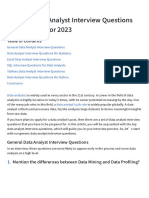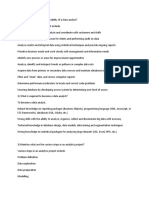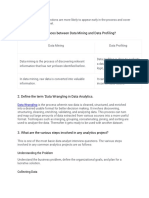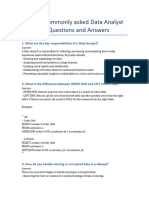0 ratings0% found this document useful (0 votes)
7 viewsData Analytics Interview
Top 50 Data ANALYST interview questions and answers
Uploaded by
Woody WoodpeckerCopyright
© © All Rights Reserved
Available Formats
Download as PDF or read online on Scribd
0 ratings0% found this document useful (0 votes)
7 viewsData Analytics Interview
Top 50 Data ANALYST interview questions and answers
Uploaded by
Woody WoodpeckerCopyright
© © All Rights Reserved
Available Formats
Download as PDF or read online on Scribd
You are on page 1/ 10
Top 50 Data ANALYST interview
questions and answers
Q1. What is data analytics?
ANS :- Data analytics is the process of examining,
cleaning, transforming, and modeling data to extract
useful information, draw conclusions, and support
decision-making.
Q 2. What are the types of data analytics?
ANS :- Descriptive, diagnostic, predictive, and
prescriptive analysis.
Q 3. Explain the difference between qualitative
and quantitative data.?
ANS :- Qualitative data is non numerical, such as text or
images, while quantitative data is numerical, such as
measurements or counts.
ecoding_knowladge
Q 4. What is data cleansing?
ANS :- Data cleansing is the process of identifying and
correcting errors, inconsistencies, and inaccuracies in
datasets.
Q 5. What is data outlier ?
ANS :- An outlier is a data point that significantly differs
from the rest of the data points in a dataset.
Q 6. Explain the difference between SQL and
NOSOL databases ?
ANS :- SOL databases are relational, use structured
query language, and have a predefined schema, while
NoSQL databases are non-relational, use various query
languages, and have a dynamic schema.
Q7. What is ETL? ecoding_knowladge
ANS :- ETL stands for Extract, Transform, and Load. It's a
process for retrieving data from various sources,
transforming it into a usable format, and loading it into a
database or data warehouse.
Q 8. What is primary key in a database ?
ANS :- A primary key is a unique identifier for each record in
table.
Q 9. What is foreign key in a database ?
ANS :- A foreign key is a field in a table that refers to the
primary key of another table, establishing a relationship
between the two tables.
Q10. Explain the difference between inner join
and outer join in SOL ?
ANS :- Inner join returns records with matching values in
both tables, while outer join returns records from one
table and the matching records from the other table, fi
ling in NULL values for non-matching records.
Q 11. What is a histogram ?
ANS :- A histogram is a graphical representation of the
distribution of a dataset, showing the frequency of data
points in specified intervals.
acoding_knowladge
Q 12. What is a box plot?
ANS :- A box plot is a graphical representation of the
distribution of a dataset, showing the median, quartiles,
and possible outliers.
Q 13. What is linear regression ?
ANS :- Linear regression is a statistical method used to mod
the relationship between a dependent variable and one or
more independent variables.
Q 14. What is overfitting ?
ANS :- Overfitting occurs when a model is too complex and
performs well .
Q15. Explain the difference between R-
squared and adjusted R-squared ?
ANS :- R-squared measures the proportion of variation in
the dependent variable explained by the independent
variables, while adjusted R-squared adjusts for the
number of independent variables in the model.
Q16. What is a confusion matrix ?
ANS :- A confusion matrix is a table used to evaluate the
performance of a classification model, showing the true
positives, true negatives, false positives, and false
negatives.
Q17. What is K-means clustering ?
ANS :- K-means clustering is an unsupervised machine
learning algorithm used to partition data into k clusters
based on their similarity.
ecoding_knowladge
Q 18. What is cross-validation ?
ANS :- Cross-validation is a technique used to evaluate the
performance of a model by splitting the dataset into
training and testing sets multiple times and calculating the
average performance.
Q19. What is a decision tree ?
ANS :- A decision tree is a flowchart-like structure used in
decision making and machine learning, where each internal
node represents a feature, each branch represents a
decision rule, and each leaf node represents an outcome.
Q 20. What is the difference between
supervised and unsupervised learning ?
ANS :- Supervised learning uses labeled data and a known
output, while unsupervised learning uses unlabeled data
and discovers patterns or structures in the data.
Q 21. Explain principal component analysis (PCA)?
ANS :- PCA is a dimensionality reduction technique that
transforms data into a new coordinate system, reducing
the number of dimensions while retaining as much
information as possible.
Q 22. What is time series analysis ?
ANS :- Time series analysis is a statistical technique for
analyzing and forecasting data points collected over time,
such as stock prices or weather data.
Q 23. What is difference between a bar chart
i ?
era apie chert 2 ecoding_knowladge
ANS :- A bar chart represents data using rectangular bars,
showing the relationship between categories and values,
while a pie chart represents data as slices of a circle,
showing the relative proportion of each category.
Q 24. What is a pivot table ?
ANS :- A pivot table is a data summarization tool that
allows users to reorganize, filter, and aggregate data ina
spreadsheet or database. ceoding_Jnovlonye
Q 25. What is data normalization ?
ANS :- Data normalization is the process of scaling and
transforming data to eliminate redundancy and improve
consistency, making it easier to compare and analyze.
Q 26. Explain the concept of data warehousing ?
ANS :- A data warehouse is a large, centralized repository
of data used for reporting and analysis, combining data
from different sources and organizing it for efficient
querying and reporting.
Q 27. What is the role of a data analyst ina
company ?
ANS :- A data analyst collects, processes, and analyzes
data to help organizations make informed decisions, identify
trends, and improve efficiency.
Q 28. How do you handle missing data in a
dataset?
ANS :- Missing data can be handled by imputing values
(mean, median, mode), deleting rows with missing data, or
using models that can handle missing data.
Q 29. How do you deal with outliers in a dataset ?
ANS :- Outliers can be dealt with by deleting,
transforming, or replacing them, or by using models that
are less sensitive to outliers.
Q 30. Describe a situation where you used data
analysis to solve a problem ?
ANS :- Answer this based on your personal experience,
detailing the problem, your approach, and the outcome.
Q 31. How do you ensure data quality and
accuracy in your analysis ?
ANS :- Ensuring data quality and accuracy involves data
cleansing, validation, normalization, and cross-referencing
with other sources, as we | as using appropriate analytical
methods and tools. ecoding_knowladge
Q 32. Describe your experience with
programming languages, such as R or Python,
used in data analysis ?
ANS :- Answer this based on your personal experience,
highlighting your proficiency
Q 33. How do you handle large datasets ?
ANS :- Handling large datasets involves using efficient
data storage and processing techniques, such as SOL
databases, para lel computing, or cloud-based solutions,
and optimizing code and algorithms for performance.
Q 34. What is your experience with data
visualization tools, such as Tableau, Power BI, or
Excel ?
ANS :- Answer this based on your personal experience and
familiarity with the mentioned tools, providing examples of
projects or tasks you have completed using them
Q 35. How do you stay. upadated on the latest
trends and developments in data analysis ?
ANS :- Mention resources such as blogs, podcasts, online
courses, conferences, and industry publications that you use
to stay informed and up-to-date. aeeding. ewladae
Q 36. How do you handle data privacy and
security concerns in your analysis ?
ANS :- By folowing data protection regulations,
anonymizing sensitive data, using secure data storage and
transfer methods, and implementing access controls and
encryption when necessary.
Q 37. How do you prioritize tasks when working on
multiple data analysis projects ?
ANS :- By setting clear goals, assessing deadlines and
project importance, alocating resources efficiently, and
using project management tools or techniques to stay
organized ecoding_knowladge
Q 38. How do you handle disagreements or
conflicts with in a team ?
ANS :- By openly discussing the issue, actively listening to
different perspectives, finding common ground, and working
colaboratively to reach a resolution.
Q 39. Describe a situation where you had to
present complex data analysis results to a non-
technical audience ?
ANS :- Answer this based on your personal experience,
detailing how you simplified the information, used visual
aids, and adapted your communication style for the
audience.
Q 40. How do you ensure your data analysis is
unbiased ?
ANS :- By being aware of potential biases, using diverse
data sources, applying objective analytical methods, and
cross-validating results with other sources or techniques.
Q Al. What metrics do you use to evaluate the
sucess of a data analysis project ?
ANS :- Metrics may include accuracy, precision, reca |, FI
score, R-squared, or other relevant performance measures,
depending on the project's goals and objectives
Q 42. How do you determine the most
appropriate data analysis technique for a given
problem ?
ANS :- By understanding the problem's context, the nature
of the data, the desired outcome, and the assumptions and
limitations of various techniques, selecting the most suitable
method through experimentation and validation.
Q 43. How do you validate the results of your
data analysis ?
ANS :- By using cross-validation, holdout samples,
comparing results with known benchmarks, and checking
for consistency and reasonableness in the findings.
You might also like
- Top 30 Data Analytics Interview Questions & Answers100% (1)Top 30 Data Analytics Interview Questions & Answers16 pages
- Data Analyst Interview Question and AnswerNo ratings yetData Analyst Interview Question and Answer51 pages
- 100 Data Science Interview Questions and AnswersNo ratings yet100 Data Science Interview Questions and Answers33 pages
- 100 Most Difficult Data Analyst Interview Q&ANo ratings yet100 Most Difficult Data Analyst Interview Q&A26 pages
- Kenny-230718-Top 60+ Data Analyst Interview Questions and Answers For 2023No ratings yetKenny-230718-Top 60+ Data Analyst Interview Questions and Answers For 202339 pages
- General Data Analyst Interview QuestionsNo ratings yetGeneral Data Analyst Interview Questions7 pages
- Program: MBA Semester-III Course: Syndicated Learning Program (SLP-3) Academic Year: 2023-24 Department of Marketing & Strategy IBS, IFHE, HyderabadNo ratings yetProgram: MBA Semester-III Course: Syndicated Learning Program (SLP-3) Academic Year: 2023-24 Department of Marketing & Strategy IBS, IFHE, Hyderabad81 pages
- 10 Most Commonly Asked DA Interview Questions and AnswersNo ratings yet10 Most Commonly Asked DA Interview Questions and Answers3 pages
- Top 30 Data Analyst Interview Questions & Answers (2022)No ratings yetTop 30 Data Analyst Interview Questions & Answers (2022)16 pages
- Data Analyst Interview Questions PDF - E-Learning PortalNo ratings yetData Analyst Interview Questions PDF - E-Learning Portal18 pages
- Most Asked Interview Questions for Data AnalystNo ratings yetMost Asked Interview Questions for Data Analyst10 pages
- Cracking The Data Analyst Interview Questions - Ebook (1)No ratings yetCracking The Data Analyst Interview Questions - Ebook (1)30 pages
- Soal Latihan IT Specialist Data AnalyticsNo ratings yetSoal Latihan IT Specialist Data Analytics12 pages
- UIIC_AO_Dataanalytics_SyllabuscoveredthroughmcqsNo ratings yetUIIC_AO_Dataanalytics_Syllabuscoveredthroughmcqs333 pages
- Cognizant Data Analyst Interview Questions 1745235888No ratings yetCognizant Data Analyst Interview Questions 174523588818 pages
- Interview Preparation Data Science AnalyseNo ratings yetInterview Preparation Data Science Analyse9 pages
- Top 50 Data Analyst Interview QuestionsNo ratings yetTop 50 Data Analyst Interview Questions51 pages
- Crack_Data_Science_Interview_�_1731300339No ratings yetCrack_Data_Science_Interview_�_1731300339132 pages
- 66 Data Analyst Interview Questions To Ace Your inNo ratings yet66 Data Analyst Interview Questions To Ace Your in38 pages
- 66 Job Interview Questions For Data ScientistsNo ratings yet66 Job Interview Questions For Data Scientists10 pages
- Trade Tariffs in 3 Levels of DifficultyNo ratings yetTrade Tariffs in 3 Levels of Difficulty10 pages
- 7 Red Flags You Are Stuck in a Dead-End JobNo ratings yet7 Red Flags You Are Stuck in a Dead-End Job12 pages
- Top 30 Data Analytics Interview Questions & AnswersTop 30 Data Analytics Interview Questions & Answers
- Kenny-230718-Top 60+ Data Analyst Interview Questions and Answers For 2023Kenny-230718-Top 60+ Data Analyst Interview Questions and Answers For 2023
- Program: MBA Semester-III Course: Syndicated Learning Program (SLP-3) Academic Year: 2023-24 Department of Marketing & Strategy IBS, IFHE, HyderabadProgram: MBA Semester-III Course: Syndicated Learning Program (SLP-3) Academic Year: 2023-24 Department of Marketing & Strategy IBS, IFHE, Hyderabad
- 10 Most Commonly Asked DA Interview Questions and Answers10 Most Commonly Asked DA Interview Questions and Answers
- Top 30 Data Analyst Interview Questions & Answers (2022)Top 30 Data Analyst Interview Questions & Answers (2022)
- Data Analyst Interview Questions PDF - E-Learning PortalData Analyst Interview Questions PDF - E-Learning Portal
- Cracking The Data Analyst Interview Questions - Ebook (1)Cracking The Data Analyst Interview Questions - Ebook (1)
- Cognizant Data Analyst Interview Questions 1745235888Cognizant Data Analyst Interview Questions 1745235888
- 66 Data Analyst Interview Questions To Ace Your in66 Data Analyst Interview Questions To Ace Your in










































































